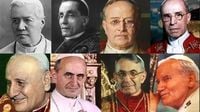What’s in a name? For the Catholic Church, a lot. The tradition of a pope adopting a new name upon election is a deeply symbolic act that reflects the values and spiritual inspirations of the new pontiff. In a historic moment for the Church, Cardinal Robert Prevost, the first U.S.-born pope, chose the name Leo XIV as the 267th head of the Catholic Church. This decision marks the continuation of a long-standing custom that dates back to the sixth century.
The practice of changing names began with Pope John II, who felt his original name, Mercurius, was inappropriate due to its pagan connotations. Since then, every pope has selected a name upon ascending to the papacy, a tradition that has remained uninterrupted since 1555. This act is not just ceremonial; it holds significant meaning for the new leader and the faithful.
Joshua McManaway, assistant professor at Notre Dame's McGrath Institute for Church Life, explained, “There are very few rules for the man at the top, so they're allowed to choose what they want.” Most popes opt for names that honor predecessors they admire or saints who inspire their ministry. For instance, Pope Francis, born Jorge Mario Bergoglio, chose his name in honor of Saint Francis of Assisi, reflecting his commitment to humility and service to the poor.
Throughout history, certain names have become quite popular among popes. The name John stands out as the most frequently chosen, appearing 21 times. This popularity is likely due to its biblical significance, with the last usage being by John XXIII from 1958 to 1963. Following closely is Gregory, which has been chosen 16 times, notably honoring Gregory I, also known as Gregory the Great, who was pivotal in reforming church liturgy in the sixth century.
Other notable names include Benedict, chosen 15 times, which is associated with theological scholarship and peace, and Clement, used 14 times, harkening back to one of the early bishops of Rome. The name Leo, selected 14 times, is particularly significant as it honors influential early popes like Leo I, who confronted Attila the Hun and helped define papal authority.
Interestingly, the name Innocent has been chosen 13 times, suggesting moral integrity, while from 1775 to 1958, seven out of 11 popes were named Pius. These choices reflect a rich history of reverence for predecessors and the values they embodied.
In a notable shift, Cardinal Albino Luciani became John Paul I in 1978, the first pontiff in nearly 1,100 years to adopt a double name. This was a tribute to both John XXIII and Paul VI, and he famously remarked, “I am John Paul the first, there will be another coming after me.” Tragically, his papacy lasted only a month before his untimely death. His successor, Cardinal Karol Jozef Wojtyła, took the name John Paul II, continuing the legacy of his predecessor.
While many names have been reused, some, like Peter, have never been chosen again. Despite no formal prohibition against the name Peter, which is associated with the first pope, it has become an unwritten rule that no pope should take that name. McManaway suggests that this may stem from a sense of humility, as no one wants to compare themselves to the apostle Peter, whom Christ himself chose. In contrast, the name Paul has been used six times, with notable popes including Paul VI, who served from 1963 to 1978.
The announcement of a new pope's name is a moment of great anticipation. The famous phrase "Habemus papam" ("We have a pope") is announced from the balcony of Saint Peter's Basilica by the cardinal protodeacon, who in 2025 will be Cardinal Dominique Mamberti. This announcement reveals the new pope's name change, marking the beginning of a new era for the Catholic Church.
Until the 56th pope, John II, was elected in 533, newly elected bishops of Rome retained their civil names. The significance of the papal name has evolved over time, reflecting the growing importance of the sovereign pontiff within the Church. The choice of a papal name now carries profound implications and is often viewed as a reflection of the new pope's mission and vision for the Church.
As Cardinal Prevost embarks on his papacy as Leo XIV, the Catholic community watches closely to see how his chosen name will influence his leadership and the direction of the Church. The name Leo carries with it a legacy of strength and moral authority, and many are hopeful that this new pontificate will address contemporary challenges while honoring the traditions of the past.
In conclusion, the tradition of papal names is a fascinating aspect of the Catholic Church, steeped in history and meaning. Each name chosen represents not just a personal preference but a connection to the broader narrative of the Church and its mission. As the Church moves forward under Leo XIV, the significance of this choice will unfold in the coming years, shaping the future of the Catholic faith.

